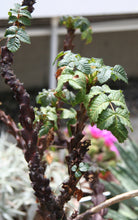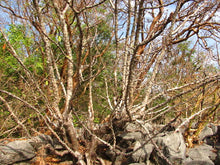Beiselia mexicana was discovered by Karl-Werner Beisel (owner of German Kakteenland) in 1982 in a remote area of Mexico, and its position in the family was not immediately clear.
A thorough study by Lewis Leonard Forman considered many characters and could only tentatively conclude that it should belong in Bursereae.
The gross morphology suggested affinities with Bursereae, pollen indicated affinities with Canarieae, and many anatomical characters indicated closer agreement with Bursereae and Protieae than Canarieae.
The main basis for its final grouping was the emphasis given to fruit characters, which showed similarities to Boswellia and Triomma fruits. B. m. has simple cotyledons; molecular studies suggest that it is sister to the rest of the family (e.g. Clarkson 2002).
This has considerable implications for character evolution, including cotyledon morphology; Beiselia also has probably derived features, like it gyneocium with its 9-12 carpels.





